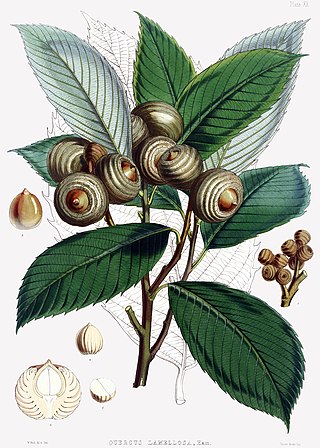
Quercus glauca, commonly called ring-cupped oak or Japanese blue oak, is a tree in the beech family (Fagaceae). It is native to eastern and southern Asia, where it is found in Afghanistan, Bhutan, China, northern and eastern India, southern Japan, Kashmir, Korea, Myanmar, Nepal, and Vietnam.

Quercus lamellosa is a species of oak native to the Himalaya and adjoining mountains from Tibet and Nepal east as far as Guangxi and northern Thailand, growing at altitudes of 1300–2500 m. The Lepcha of Sikkim call it book koong.

Quercus myrsinifolia is an Asian species of tree in the ring-cupped oaks subgenus of the family Fagaceae. It has several common names, including bamboo-leaf oak, Chinese evergreen oak, and Chinese ring-cupped oak. Its Chinese name is 小叶青冈; pinyin: xiǎo yè qīng gāng, which means little leaf ring-cupped oak, in Japan it is called white oak and in Korea it is known as gasinamu (가시나무). It is native to east central and southeast China, Japan, Korea, Laos, northern Thailand, and Vietnam.
Quercus asymmetrica is the accepted name of an endemic oak tree species in the Asian sub-genus of 'ring-cupped oaks' and the family Fagaceae. It is found in China and northern Vietnam.
Quercus augustinii is a rare species of tree in the family Fagaceae and the "ring-cupped oak" sub-genus. It has been found in Vietnam as well as Guangxi, Guizhou, and Yunnan Provinces in southern China.
Quercus austrocochinchinensis is an uncommon species of tree in the family Fagaceae and the "ring-cupped oak" sub-genus. It has been found in Vietnam and Thailand as well as Yunnan Province in southern China.
Quercus chevalieri is an uncommon species of tree in the family Fagaceae and the "ring-cupped oak" sub-genus. It has been found in Vietnam and also in southern China, in the Provinces of Guangdong, Guangxi, and Yunnan.
Quercus edithiae is a species of tree in the family Fagaceae and the "ring-cupped oak" sub-genus. It has been found in Vietnam and also in southern China, in the Provinces of Guangdong, Guangxi, and Hainan. In Vietnam it is called sồi editha.
Quercus fleuryi is a species of tree in the family Fagaceae and the "ring-cupped oak" sub-genus. It has been found in Indochina, and southern China.

Quercus gilva, the red-bark oak, is a species of tree in the beech family. It has been found in Japan, Korea, and southeastern China.
Quercus kerrii is an uncommon Asian species of tree in the family Fagaceae and the "ring-cupped oak" sub-genus. It is native to Thailand and Vietnam. There are also populations in southern China that according to some authors belong to Q. kerrii but considered by others to belong to a different species, Q. helferiana.
Quercus longinux is an uncommon Asian species of trees in the beech family. It has only been found in Taiwan.
Quercus oxyodon is a tree species in the Asian sub-genus of 'ring-cupped oaks' and the family Fagaceae. It is native to the Himalayas and to the mountains of southern China and the Sa Pa region of northern Vietnam.
Quercus poilanei is an Asian species of tree in the family Fagaceae and the "ring-cupped oak" sub-genus. It has been found in northern Indochina and also in the Province of Guangxi in southern China.

Quercus rex is an Asian species of tree in the family Fagaceae and the "ring-cupped oak" sub-genus. It has been found in the seasonal tropical forests of northern Indochina, northeastern India, and also in the province of Yunnan in southwestern China.
Quercus saravanensis is an Asian species of tree in the family Fagaceae and the "ring-cupped oak" sub-genus. It has been found in northern Indochina, and also in the Province of Yunnan in southwestern China.
Quercus thorelii is an Asian species of tree in the family Fagaceae and the "ring-cupped oak" sub-genus; the species is named after the French botanist Clovis Thorel. It has been found in Indochina and in southern China.
Quercus langbianensis is the accepted name of an uncommon oak tree species in the Asian sub-genus of Cyclobalanopsis in the family Fagaceae. These differ from other Quercus subgenera in that they have acorns with distinctive cups: usually with substantial rings, made-up of scales that have grown together. This species can be found in sub-tropical and tropical seasonal forests of Cambodia, China and Vietnam.
Quercus auricoma is the accepted name of a tree species in the Asian sub-genus of 'ring-cupped oaks' and the family Fagaceae; there are no known subspecies.




